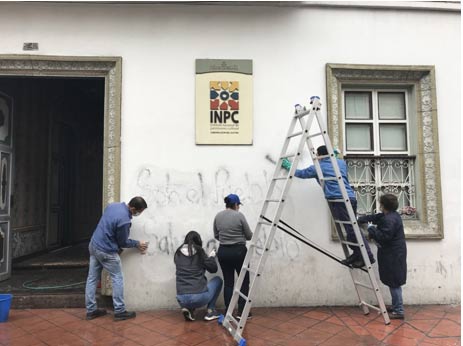These days, town halls tend to equate unsanctioned graffiti with vandalism, identifying it as a costly “problem” or eyesore. All too often local administrations prioritize the quick removal of graffiti, following the lead of the now defunct broken windows theory, proposed by James Q. Wilson and George Kelling in 1982, which claims that visible disorder such as graffiti encourages further crime. It’s a theory which anti-graffiti warriors love to quote ad infinitum, particularly followers of the Keep America Beautiful movement, and its ex-sidekick Graffiti Hurts, as well as similar organizations which have popped up throughout the world.
In response to the officially sanctioned whitewashing of graffiti which appeared in Cuenca during the October 2019 indigenous protests in Ecuador, I worked on a research project for the University of Azuay in southern Ecuador evaluating graffiti management strategies being used in different cities across the globe. The aim was to understand other ways in which the Municipality could have reacted. In essence the project was an attempt to answer a question posed by Dr. Richard Clay in the BBC FOUR documentary A Brief History of Graffiti: “Should we always succumb to the knee-jerk reaction of scrubbing it off?”

Cleaning graffiti which states “Solo el Pueblo Salva el Pueblo” (only the people can save the people) from the façade of the National Institute of Cultural Heritage (INPC) in Cuenca on October 10, 2019. (Cecilia Bogaard)
Is Graffiti a Modern Phenomenon?
While many believe graffiti to be a modern phenomenon, popularized in Philadelphia and New York in the 1960s, graffiti in different forms actually has a far longer history. Uninvited markings, written, drawn, scratched, etched, or sprayed onto a variety of surfaces have been created throughout history. From the 30,000-year-old hand stencil found in the Grotte d’Arcy caves of France, graffiti etched into the walls in Pompeii, and the political slogans of the French Revolution, there’s actually nothing new about graffiti.
Ancient Egypt was no stranger to graffiti either. In fact, over 1,000 inscriptions from the tomb of Ramesses VI in the Valley of the Kings were studied by a team from the University of Warsaw. These included a 2,000-year-old Roman inscription which, much like a recommendation on TripAdvisor, stated “I visited and I did not like anything except the sarcophagus.” Graffiti has also been found at the great pyramid of Giza in locations where it was never meant to be seen. These 4,500-year-old markings have allowed experts to piece together a clearer picture of how gangs of workers built the pyramids.

Viking graffiti was discovered within a stone chamber tomb at Maeshowe in Orkney. (Bengt A Lundberg / CC BY 2.5)
Viking graffiti was even discovered at Maeshowe in the Orkney Islands of Scotland. It appears that a group of Norsemen took refuge within an ancient tomb built about 5,000 years ago. On the white marble parapet of the Hagia Sophie mosque in Turkey, a ninth century Viking even carved his name with the overly imaginative inscription “Halfdan was here.” While these kinds of ancient graffiti can seem frivolous, they can teach us a great deal about the realities of their authors and the eras in which they lived.
Archaeologist Matthew Champion published the book Medieval Graffiti in 2015, having focused his attention on medieval church graffiti in England as a way to enter the mindset of what he saw as the underrepresented lower classes of that era. “They are, quite literally, the lost voices of the medieval church,” highlighted History Extra. These inscriptions carved into stone within medieval churches “tell the stories of life, love, hope and fear within the English medieval parish.”
Want to know more? Appreciating the history of graffiti as a form of social expression can lead to more democratic responses to graffiti in public spaces. In some cases, graffiti acts as a portal to understand historic events and current social movements, deserving recognition and protection as part of our heritage. Read the article ‘Talking Walls: What Graffiti Should be Saved?’ available in the May – June 2024 50th Issue Special Edition of Ancient Origins Magazine. Get it here!
Featured Image: Deliberately preserved graffiti within the German Reichstag in Berlin. Source: Ole Neitzel / CC BY-SA 4.0
By Cecilia Bogaard




